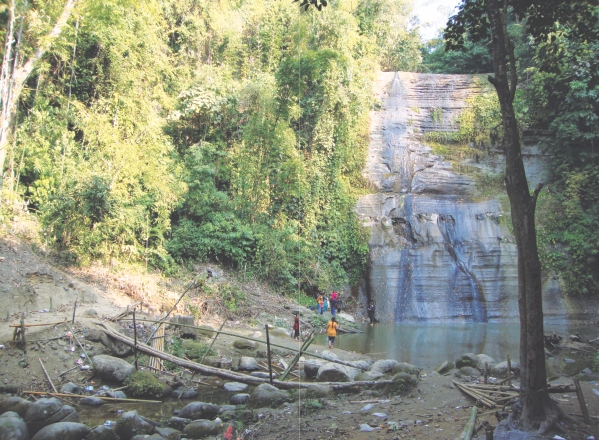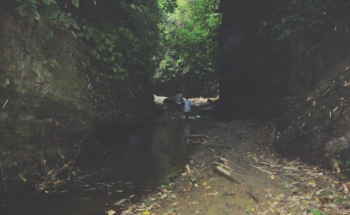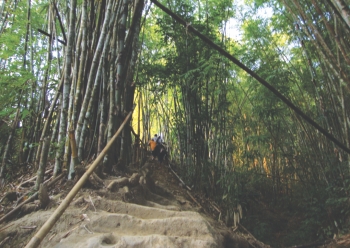| Home - Back Issues - The Team - Contact Us |
 |
| Volume 11 |Issue 19 | May 11, 2012 | |
|
|
Travel
Nature's Photo Op Srimangal is only four hours away from Dhaka. The Hammam Waterfall near Srimangal can be an adventurous weekend getaway for holiday makers. Akram Hosen Mamun It is a given that in the age of gizmos and gadgets most sightseeing these days is done through the lenses of cameras or cellphones. When we, a group of seven friends, went to see the Hammam waterfall – “discovered" a few years back by some amateur trekkers – every one of us maneuvered the icy-cold, knee deep water and the slippery mud with eyes fixed on the screens of mini cameras and smart phones. Wielding a camera in one hand and a walking stick in another did not make hiking any easier, but putting the cameras in the backpack was not even considered. The waterfall is located in Kamalganj, Moulvibazar. But we stayed at a hotel in Srimangal, because it is convenient to visit the tea estates and Lawachara rainforest from there. Knowing that we were planning to visit Hammam, the hotel keeper suggested that we hire a chander gari (moon car) for the journey. Contrary to what the name may suggest, chander gari is just a somewhat beat-up roofless pickup truck, not an exotic vehicle. We rented it for Tk 1900 a day. As the road snaked through the forest and hills, some of us tried to capture the picturesque lush greenery of the forest in the gadgets, but failed to take any steady shot for obvious reasons. So as the truck sped up and down the hill, we looked at the tangled mass of overgrown shrubbery among the large trees with naked eyes.
The truck dropped us in Kolabon Para village by 9am. The road ended there. It took three hours of hiking through the forest to reach the waterfall. At the outskirts of the village, where the trails began, some villagers approached us and strongly recommended that we take a guided tour. "It will cost only Tk 300," they pleaded. But for understandable reasons, the two couples, who were with us, thought the presence of a stranger would be a killjoy for them; the others wanted to take a guide. Our group was divided into two camps. Finally, we decided go alone. However, listening to the advice of the local people, we took water bottles, snacks and small bamboo sticks that became handy while walking on the slippery ground. Children of the local village sell the sticks for Tk 5 only. One of the unique aspects of the forest was that it lacks developed trails. You can really take off in any direction and enjoy walking in the woods for hours. But not all trails lead to the waterfall. After walking an hour along the small stream (locally known as chhara), we noticed that the trail we were following had split into two paths. We took the one that went uphill, because it involved climbing steep hillocks and looked more treacherous and hence adventurous. The jungle seemed darker and the bushes seemed impassable after climbing for an hour. The foliage to our left was shaking. It was a monkey. For a few seconds, it hung transfixed from a branch and stared at us. But it disappeared with sudden graceful moves before anybody had a chance to aim their cameras. However, the trail then went down a steep slope. After another twenty minutes of climbing down, we reached the dead end of the trail and to an impenetrable jungle. As I began to applaud myself for reaching to a part of the forest where nobody had come before, Archi, one of the friends, found an empty plastic water bottle and several packs of Energy Plus biscuits. That is when we realised how the forest suffers from a massive surge of tourists. Wildlife of the area is being diminished everyday by people like us. Marks of inconsiderate littering were almost everywhere. Trees have been cut and felled leaving bald spots that looked like open scars in the greenery. I could imagine what the place would become if the Department of Forest do not move to take control of the area and declare it as a reserved forest. However, after losing two hours following the wrong trail, we came back to the stream again. The tree branches were shaking somewhere near. It was no primate this time. A man with an ax was cutting branches, collecting firewood for the village. "I knew that you'd return here when I saw you taking that trail,” he said and laughed. “Keep along the chhara if you have hope of ever reaching that waterfall," he added. We followed his advice. Steep hillocks flanked the brook. In places, the trail disappeared underwater with steep rocks on both sides. So we had to walk in the fast flowing knee-deep water. There was something terribly frustrating in seeing plastic water bottles floating downstream on the clean water. After a while my feet were stiff with cold. I thought I could not feel my toes anymore and silently cursed the cameras for slowing us down.
The waterfall was mighty. The precipice was nearly 30 feet in width and about 100 feet in height. The flow of water varies dramatically according to rainfall. Unfortunately, it hadn't rained for a couple of days when we went there. Some twenty tourists with mini cameras were already there, doing what most of us were doing: taking pictures of the waterfall or people posing in front of the waterfall. Everyone ended up taking pictures of people taking pictures of the cliff. Since none of the visitors were carrying a traditional full-service camera, they were not actually holding the camera to the eye. There was something strange about watching people looking at those small screens, standing in front of a waterfall. “Above all, the photos are a proof that I was here,” said a woman with a cell phone. And what would happen to the thousands of pictures she was taking? "They will take residence on the cloud, available for my friends to see in Facebook," she said. But what's most depressing about the place is the inconsiderate littering. Sleek surfaces of boulders of rocks were strewn with leftovers of snacks, plastic bottles, and cigarette stubs. The department of forest had done nothing to preserve the integrity of the place. Paying a little attention to the ecological sensitivity and acting a little more responsibly could save such a Shangri-La. The sun had set before we reached Kolabon Para. It was a clear night. In the bright moon light, the various shades of green became fascinating shadows. The fact that a mere four hours away from the overcrowded capital Dhaka lie the rainforests and waterfalls is testament to Bangladesh's diverse scenic beauty.
|
||||||||
Copyright
(R) thedailystar.net 2012 |


